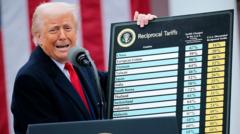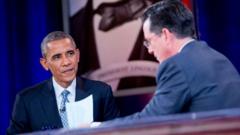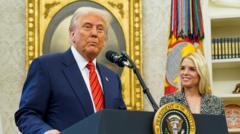The re-introduction of tariffs on Chinese-made smartphones is intended to safeguard U.S. manufacturing, despite earlier claims of exemptions which have been dismissed by Trump as inaccurate information.
**Trump Revokes Smartphone Tariff Exemptions, Promises New Levies**

**Trump Revokes Smartphone Tariff Exemptions, Promises New Levies**
In a surprising twist, Trump announces tariffs on electronics despite prior exemptions, signaling potential repercussions for the global tech market.
Former President Donald Trump has reversed his recent decision to exempt smartphones and electronics from tariffs on imports from China, asserting that these products will instead fall under a different “tariff bucket.” Following some initial relief in European stock markets after Trump’s announcement that certain products would not incur levies of up to 145%, the mood has shifted with the expectation of new semiconductor tariffs.
China has responded forcefully, urging the U.S. to withdraw its tariffs regime entirely and move towards a resolution based on mutual respect. In a typical back-and-forth of the ongoing trade war, U.S. officials clarified that various electronic devices, including smartphones, are poised for the new semiconductor tariffs, which were alluded to by Commerce Secretary Howard Lutnick.
As global supply chains continue to be affected, Trump reinforced the belief that America must produce its own semiconductors and electronics domestically. On Saturday, a customs notice indicated that while smartphones, computers, and other electronics would be exempt from an existing tariff, Trump countered this information on social media, labeling it false news and claiming that the products would instead transition to new tariffs.
Semiconductors, the tiny but critical components integral to modern electronics, are at the heart of this economic maneuvering. As concerns rise over the impact of such tariffs on consumer prices and the tech industry, Sony announced a price increase of approximately 10% for its PlayStation 5 console in various international markets, attributing the rise to inflation and economic challenges.
However, Trump’s proposed tariffs continue to cast a shadow of uncertainty over U.S.-China trade relations. With a tense atmosphere following the U.S. imposing a tariff of 54% in April, which escalated to 145%, the unpredictable nature of tariffs has left consumers and businesses uncertain.
The Chinese ministry has also highlighted that these temporary tariff exemptions fail to resolve underlying trade tensions, indicating a tit-for-tat retaliation strategy. As tensions amplify, U.S. Trade Representative Jamieson Greer stated there are currently no plans for Trump to engage in dialogue with Chinese President Xi Jinping, leaving the future of U.S.-China trade relations in a precarious state.
Nonetheless, the White House continues to assert that tariffs play a pivotal role in negotiating better trade terms, pledging to reclaim jobs and secure American manufacturing, all while fear looms over potential economic repercussions. The strategy serves as a reminder of the delicate balance between trade policy and global market stability.






















